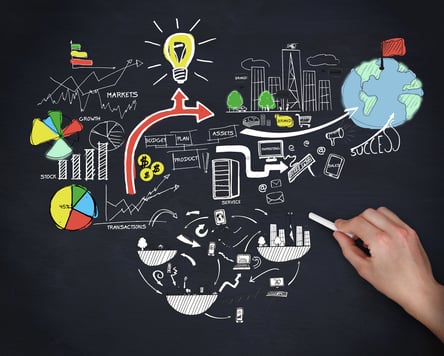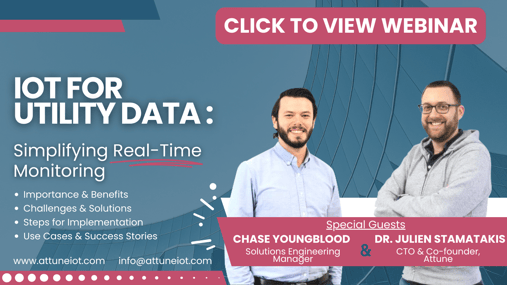7 IoT Technology Trends in 2024
There's plenty on the horizon for the Internet of Things in 2024. Learn about the most cutting-edge IoT developments that will soon be standard in homes, commercial buildings, manufacturing plants, and cities.

"If these walls could talk" used to be nothing more than a saying. Now, Internet of Things (IoT) technology allows walls, sewers, faucets, security cameras, and more to chitchat about all types of things.
Businesses and building owners continue to discover great benefits from connecting IoT sensors to key systems, as they offer valuable data concerning the health and operational efficiency of their buildings. However, the Internet of Things remains in its infancy, and many powerful developments lie on the horizon this year.
Below are seven relevant IoT technology trends for building managers to boost their operational efficiency and maintain green buildings that benefit the environment.
1. Enhanced IoT Security Protocols
IoT devices deal with massive data transfers. As building managers use smart devices to harvest larger, more useful datasets, data breaches become a greater threat.
IoT security is a huge concern. Reports show that IoT-targeted malware attacks are increasing by 37% annually, and as attack surfaces grow larger, hardening IoT networks through stronger encryption and security protocols is vital.
A growing trend with IoT services is a more holistic stance toward securing real-time data transfers. A few of these practices include endpoint security, multifactor authentication, code obfuscation, and strict cloud storage access controls.
2. Wider Range of Connectivity Options
Strong connectivity is key to successful IoT operations.
There are many emerging options for powering effective IoT solutions. For example, 5G connectivity is now in its wide-scale adoption phase, which allows for rapid communication and quicker data analysis, meaning businesses can make more informed decisions faster than ever.
Without stellar connectivity, building occupants face more danger. Certain IoT-powered alerts, such as one for a gas leak, require immediate action. Connection delays, latency, or slow data transfers can make a serious difference in how IoT systems process data and issue alerts.
Edge computing is another emerging IoT-related development. This tech allows businesses to prioritize and structure data transfers across network devices. This is especially relevant in the age of remote work, as edge devices may be sending highly valuable data from thousands of miles away.
Take an IoT-enabled security camera as an example: With edge computing, instead of sending all of the footage to a central hub, it sends only the relevant footage. This frees up bandwidth, allowing more important data to travel faster and without bottlenecks.
3. Industrial IoT
Industry 4.0 technologies allow manufacturers and commercial entities to achieve full-scale automation, improve their supply chain efficiency, and improve their inventory strategy. However, to drive these benefits with smart devices, companies must rig key tools, applications, and processes with the right IoT solutions.
For example, one major IoT-powered trend in the industrial world is digital twins. A digital twin is a virtual replica of an industrial machine or process. Through IoT sensors, production managers can run virtual tests on digital twins to understand their peak capacity or monitor their performance to boost their productivity.
4. Expansion of IoT in Healthcare
The healthcare industry is one of the primary beneficiaries of IoT tech. One major way IoT technology is revolutionizing the medical field is through remote patient monitoring.
IoT solutions allow medical professionals to offer remote care outside of a traditional healthcare setting. With the right IoT monitoring solutions, medical professionals can track a patient's status from afar through the hospital's existing IT infrastructure.
Additionally, IoT technology continues to galvanize medically useful wearable devices. With better remote functionality, medical professionals can accurately monitor heart rates, blood pressure, and other vital signs from a distance. In certain cases, they can even adjust wearable devices to care for patients 100% remotely.
Overall, the remote functionality frees up physical space for healthcare facilities to treat more intense cases. It helps them save on costs and heightens the daily lives of patients, allowing many to receive care from the comfort of their homes.
5. Sustainable IoT Solutions for Environmental Monitoring
One out of six people lives under the threat of an environmental hazard, often due to overconsumption and a lack of resources. However, IoT solutions can aid governments, businesses, and homeowners, allowing them to analyze their consumption habits and take steps to curb the environmental threats caused by wastefulness.
As IoT solutions become more powerful, it becomes easier to understand energy consumption and carbon footprints in greater detail, making it easier to diagnose problems, avoid regulatory penalties, and meet sustainability goals.
6. IoT in Smart City Development
IoT technology is a modern solution for urban planning. As it becomes more accessible, municipalities can connect urban landscapes to gain insights that can lead to preferable outcomes, such as:
- Less traffic congestion
- Safer traffic laws
- Lower emissions
- Cleaner air quality
- Better electric grids
- More effective security systems
Now, ecologists, city officials, legal professionals, and safety experts can use IoT solutions to merge datasets across urban planning initiatives and sensibly allocate their budgets to solve issues and improve the lives of citizens.
Ultimately IoT technology empowers officials with proactive tools for long-term planning, rather than relying on a reactive stance toward the issues that plague their cities.
7. Advancements in Big Data and Machine Learning
At last, modern mechanisms like artificial intelligence, cloud computing, and IoT solutions are merging. This intersection creates more powerful insights and more productive buildings, schools, manufacturing plants, and supply chains.
IoT technology acts as the first step, gathering data that feeds and informs algorithms, leading to sharper insights that facilitate predictive maintenance and continuous improvement. Whether it's with utility consumption or factory floor layouts, combining IoT solutions with big data leads to more mature predictions faster than ever before.
Join Us on the Cutting Edge of IoT Technology
To reap the benefits of connected devices, your equipment requires the best IoT platform, connectivity, and sensors.
Consider partnering with Attune if you're searching for the most functional, effective, and technologically advanced IoT hardware and software. Our system can be up and running within a day.
Come see how it works. Contact us today to schedule a demo.
